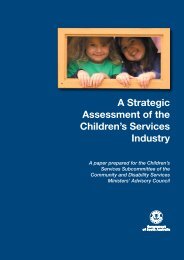Global Study On Child Poverty And Disparities (PDF) - Social Policy ...
Global Study On Child Poverty And Disparities (PDF) - Social Policy ...
Global Study On Child Poverty And Disparities (PDF) - Social Policy ...
You also want an ePaper? Increase the reach of your titles
YUMPU automatically turns print PDFs into web optimized ePapers that Google loves.
Thus, geography is critical to understanding the<br />
development challenges and constraints facing<br />
Vanuatu. Basic social service delivery has high<br />
per-unit costs, and there are capacity restraints<br />
to developing infrastructure. This implies some<br />
ongoing disadvantages for remote areas, such as<br />
distance from hospitals.<br />
Political context<br />
Vanuatu gained its independence in 1980, after<br />
74 years of joint rule by Britain and France. It is a<br />
democratic republic with a 52-member Parliament<br />
elected every four years. The Prime Minister,<br />
Vanuatu’s Head of Government, is elected by the<br />
members of Parliament for a period of five years.<br />
There are 13 government ministries, which are led<br />
by 13 members of the Council of Ministers, which<br />
also has a significant role in policy and budget<br />
execution.<br />
Vanuatu held national elections on 2 September<br />
2008. <strong>On</strong> 22 September 2008, Edward Natapei<br />
was elected Prime Minister by two votes in<br />
a secret ballot at the first sitting of the new<br />
parliament. After facing numerous votes of no<br />
confidence the Natapei government was defeated<br />
on 2 December 2010. The Deputy Prime Minister<br />
under the Natapei government, Sato Kilman,<br />
(People’s Progressive Party) became the new<br />
Prime Minister. The Kilman-led government is a<br />
loose alliance of eight parties.<br />
Figure 1.2: Population structure in 2006<br />
Female<br />
Male<br />
3,880 5,390<br />
2,310 2,690<br />
3,160 3,550<br />
4,070 4,100<br />
4,950 5,610<br />
6,410 5,930<br />
8,330 8,600<br />
9,380 9,000<br />
10,550 9,360<br />
9,960 9,910<br />
11,590 12,790<br />
12,710 14,300<br />
12,180<br />
12,730<br />
Source: ADB, UNDP and GOV 2006.<br />
Although it has declined from 5.3 in 1989,<br />
Vanuatu’s fertility rate, 4.0 in 2009, was among<br />
the highest among the PICs, as shown in Figure<br />
1.3. Fertility rates are significantly higher in rural<br />
areas than in urban areas (5.1 compared to 3.8<br />
in 1999). 3 Teenage fertility rates are also high, 65<br />
per 1,000 females age 15 to 19 in 2009.<br />
60+<br />
55-59<br />
50-54<br />
45-49<br />
40-45<br />
35-39<br />
30-34<br />
25-29<br />
20-24<br />
15-19<br />
10-14<br />
5-9<br />
0-4<br />
The relationships between the National<br />
Government, provincial governments, and the<br />
municipal administrations of Port Vila, Luganville<br />
and Lenakel are important. In addition, the<br />
National Council of Chiefs has a role under the<br />
Constitution, which upholds matters of custom<br />
and tradition. Each island has an Island Council<br />
of Chiefs, which has responsibility for resolving<br />
disputes according to traditional local custom<br />
(ADB 2009, p. 47).<br />
Population<br />
The total population of Vanuatu was estimated<br />
to be 234,000 in 2009, and it is projected to be<br />
245,000 in 2010. The median age is 20.6 years,<br />
amongst the youngest in the Pacific. Figure 1.2<br />
shows the population structure in 2006. The<br />
largest age cohort is 5 to 9 years, followed by 10<br />
to 14 years and 0 to 4 years. Boys outnumber<br />
girls up to the age of 15, but between 15 and<br />
29 years, women outnumber men. This again<br />
reverses over the age of 30.<br />
Figure 1.3: Total fertility rates, Pacific Island<br />
countries<br />
Northern Marianas<br />
Palau<br />
Wallis <strong>And</strong> Futuna<br />
French Polynesia<br />
New Caledonia<br />
Cook Islands<br />
Fiji Islands<br />
Niue<br />
Guam<br />
Nauru<br />
Kiribati<br />
Tuvalu<br />
American Samoa<br />
FSM<br />
Vanuatu<br />
Samoa<br />
Tonga<br />
Marshall Islands<br />
Papua New Guinea<br />
Tokelau<br />
Solomon Islands<br />
0.0 0.1 1.0 1.5 2.0 2.5 3.0 3.5 4.0 4.5 5.0<br />
Source: SPC, 2010<br />
A number of PICs have relatively high rates<br />
of outward migration, but Vanuatu does not.<br />
This factor, in combination with the country’s<br />
youthful age structure and high fertility, means<br />
3 http://www.spc.int/prism/country/vu/stats/SOCIAL/DEMOGRAPHY/demog-sum.htm,<br />
accessed 23/11/2009.<br />
20
















